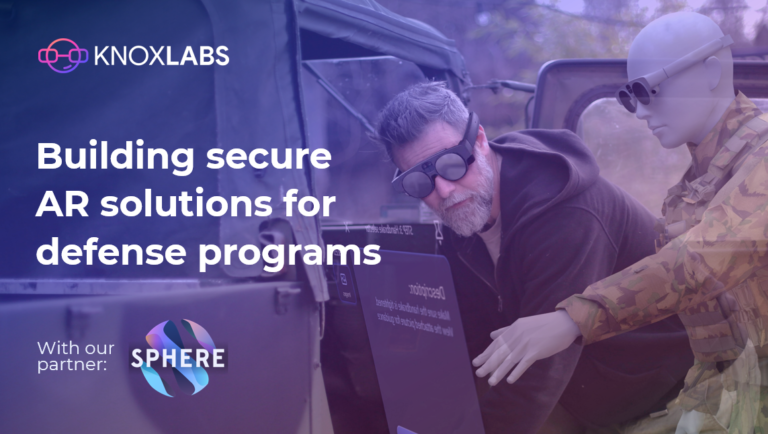On May 30, 2024, Knoxlabs and Sphere hosted an insightful webinar focused on the transformative potential of augmented reality (AR) in defense applications. The session featured expert panelists Taron Khachatryan, Founder and Chief Scientist at Knoxlabs, Jason Lee, Global Head of Sales at Sphere, and Jake Ledner, Product Manager at Sphere. The webinar delved into the advantages of AR, common use cases, security considerations, and future trends in immersive technology.
About Knoxlabs and Sphere
Knoxlabs is an XR launchpad dedicated to helping companies discover, deploy, and purchase XR technology tailored to their specific needs. With a comprehensive approach, Knoxlabs serves as a marketplace, support service, and discovery engine for XR solutions.
Sphere, founded in 2015, is a leading AR SaaS provider that specializes in spatial collaboration. Backed by Series A funding, Sphere focuses on delivering built-for-purpose AR solutions designed to enhance business operations.
Panelists
- Taron Khachatryan: Founder and Chief Scientist at Knoxlabs, Taron brings a wealth of knowledge and experience in the XR industry, driving innovation and thought leadership.
- Jason Lee: As the Global Head of Sales at Sphere, Jason is dedicated to helping companies leverage XR technologies to solve real-world business problems.
- Jake Ledner: Product Manager at Sphere, Jake excels in creating user-friendly AR products that prioritize simplicity and usability.
Immersive Technologies Overview
The webinar began with an overview of immersive technologies provided by Taron Khachatryan and Jake Ledner:
- Virtual Reality (VR): Complete immersion into a fully digital environment, often used for gaming and training.
- Augmented Reality (AR): Digital elements overlayed onto the real environment, enhancing interaction with the physical world.
- Mixed Reality (MR): Seamless merging of real and virtual elements, allowing users to interact with both simultaneously.
- Extended Reality (XR): A term encompassing VR, AR, and MR, representing the full spectrum of immersive technologies.
Common AR Use Cases in Defense
Jake Ledner highlighted several practical AR use cases, each offering unique benefits for defense applications:
- Remote Assistance: Enables on-site personnel to receive real-time guidance from remote experts through AR headsets. This setup facilitates troubleshooting, maintenance, and repairs, enhancing efficiency and knowledge transfer.
- Guided Training: Provides immersive training experiences using spatially anchored instructions. This method is particularly effective for process and procedure training, allowing users to interact with real-world objects in a controlled environment.
- Collaboration: Facilitates interactive, shared views of 3D models for multiple users, whether they are co-located or remote. This capability enhances teamwork and communication, critical in defense scenarios.
- Presentation: Allows for the demonstration of large-scale assets or designs in AR, making them interactive and accessible across various platforms. This feature is valuable for strategic planning and mission rehearsals.
Key Benefits of AR for Defense Applications
Jason Lee elaborated on the key benefits of AR for defense, emphasizing improved operational decision-making, enhanced situational awareness, and predictive maintenance:
- Improved Operational Decision Making: By collecting and visualizing real-time data from various sources, defense organizations can make more informed decisions on the battlefield, during deployments, and in resource allocation.
- Enhanced Situational Awareness: AR provides a comprehensive picture of the battlefield through real-time data from troops, drones, and other sources, enabling commanders to react swiftly and effectively to emerging threats.
- Predictive Maintenance: Data analysis on equipment performance helps predict potential failures and schedule maintenance proactively, improving equipment uptime and reducing repair costs.
Case Study: RUAG Ltd.
A significant portion of the webinar focused on a case study featuring RUAG Ltd., a key technology partner of the Swiss Armed Forces. RUAG sought to optimize training and remote support processes to streamline workflows, boost machine availability, and minimize response times. Using AR, RUAG enhanced its maintenance procedures for military aircraft, allowing remote experts to guide on-site technicians through complex tasks, thus ensuring operational readiness and reducing downtime.
Building Secure XR Solutions
Security is paramount in defense applications, and the webinar addressed several critical aspects:
- Data Security: Ensuring that all data and traffic are encrypted and stored securely, whether on-premises or in the cloud.
- Network Flexibility: Offering deployment options that include public cloud, private cloud, on-premises, and GovCloud to meet various security requirements.
- Access Control: Implementing role-based access control to ensure that users have appropriate permissions and visibility.
- Compliance: Adhering to industry standards such as ISO and SOC2 to ensure robust security measures.
Addressing Security Needs
Jake Ledner explained how Sphere addresses security concerns:
- Cross-Platform Support: Sphere’s AR solutions are device-agnostic and compatible with existing applications, ensuring seamless integration.
- Flexible Deployment Options: Sphere can be deployed in various environments, providing organizations with the flexibility to choose the best option for their needs.
- Microsoft Teams Integration: Enhances collaboration by integrating with widely-used platforms.
- Extensive File Support: Sphere supports over 60 file types, facilitating comprehensive data handling and management.
Future of AR and Immersive Tech
The panelists shared their visions for the future of AR and immersive technology:
- AI Integration: Jake highlighted the potential of combining AR with AI to provide more contextual and actionable insights. This integration can transform user interaction by enabling AI to interpret visual data from AR headsets and provide real-time guidance.
- Live Translation: Jason discussed the development of live translation capabilities in AR, which would allow global teams to communicate in their native languages in real-time, thus eliminating language barriers and enhancing collaboration.
- Neural Interfaces: Looking further ahead, Jason touched on the potential of neural link technologies to revolutionize AR by enabling direct brain-to-device communication. While still in its infancy, this technology could open new frontiers in human-computer interaction.
Q&A Session Highlights
The webinar concluded with a Q&A session, addressing several pertinent questions from the audience:
- AR Hardware Readiness: The panelists confirmed that AR hardware, such as the Magic Leap 2, is ready for most real-world applications, although there are some limitations in outdoor environments.
- Command and Control Use Cases: AR is highly effective for command and control, providing real-time data visualization and situational awareness. This capability enhances strategic planning and decision-making.
- Integration with Existing IT Infrastructure: The panelists emphasized the importance of a flexible, API-based integration approach to ensure seamless interoperability with existing systems.
Closing Remarks
Taron Khachatryan wrapped up the session by encouraging participants to explore AR technology through pilot programs and thanking them for their participation. He invited attendees to connect on LinkedIn and reach out to Knox and Sphere for further inquiries and support.
Contact Information:
- Knox: hello@knoxlabs.com, Knoxlabs LinkedIn
- Sphere: sales@sphere.tech, Sphere LinkedIn
This webinar provided a comprehensive overview of the transformative potential of AR in defense applications. By leveraging AR technology, defense organizations can enhance operational efficiency, situational awareness, training, and maintenance, paving the way for a more secure and effective defense infrastructure.










+ There are no comments
Add yours